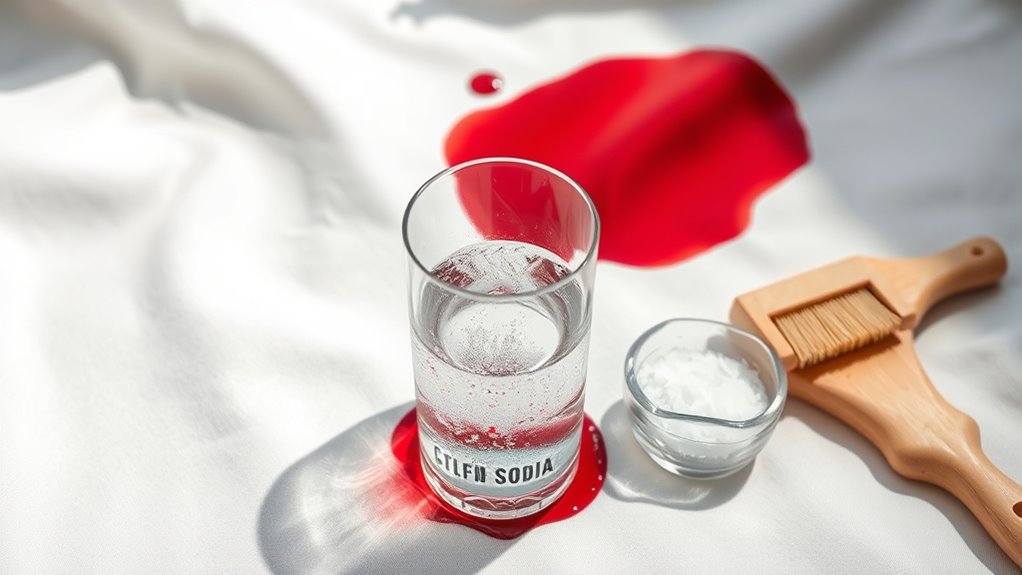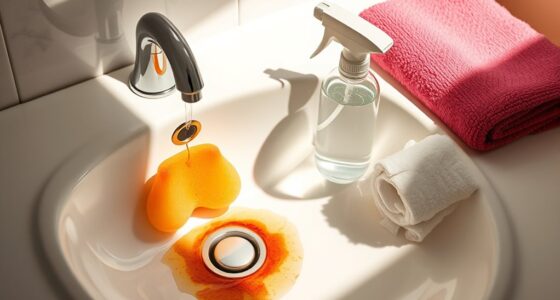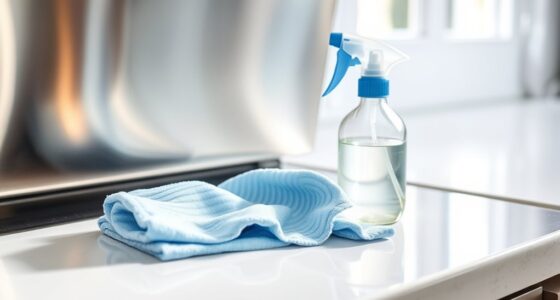Effective stain removal hinges on understanding stain types, like enzymatic and oxidisable. Enzymes, such as proteases and lipases, break down protein and greasy stains, while surfactants attract oil and help lift residues. Builders enhance surfactant efficiency, especially in tough water conditions. Different fabrics require tailored treatments to avoid damage, and knowing when to seek professional assistance can guarantee your garments stay pristine. There’s plenty more to uncover about the science that makes stain removal successful.
Key Takeaways
- Effective stain removal relies on understanding stain types, including enzymatic, oxidisable, greasy, and particulate, each requiring different treatment methods.
- Enzymes like proteases and lipases break down protein and greasy stains, enhancing cleaning efficiency when used at optimal temperatures.
- Surfactants encapsulate and wash away greasy residues, with their effectiveness influenced by concentration and type, such as anionic, cationic, or nonionic.
- Builders soften water and prevent dirt redeposition, improving surfactant performance, especially in hard water areas and with soil stains.
- For stubborn or delicate stains, professional cleaning services utilize advanced techniques and products to ensure effective treatment without damaging fabrics.
Types of Stains and Their Characteristics
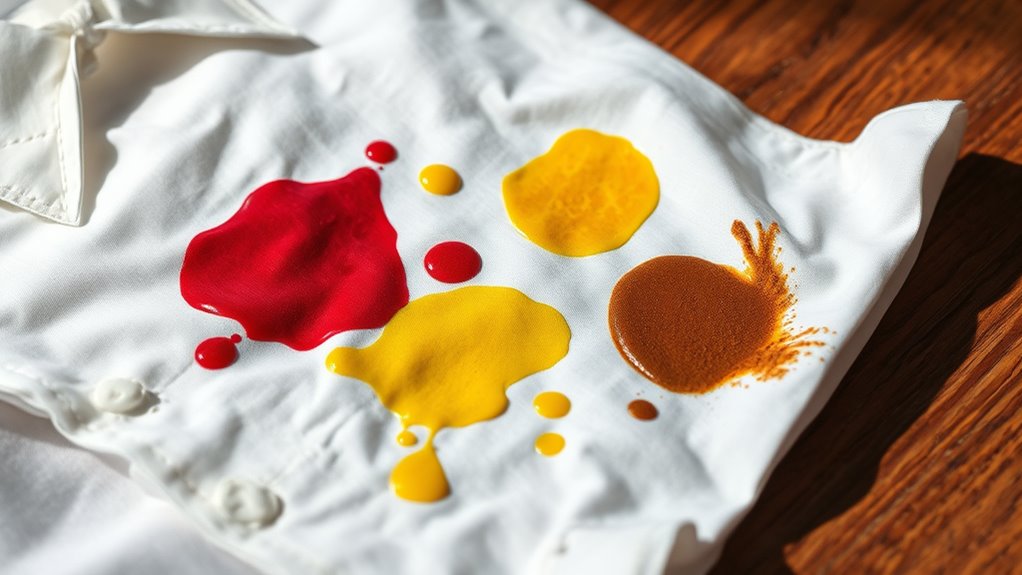
When it comes to tackling stains, understanding their types and characteristics can make all the difference in your cleaning efforts.
There are four main types of stains: enzymatic, oxidisable, greasy, and particulate. Each requires specific stain removal techniques. Regular maintenance of your cleaning tools, such as air purifiers, can also enhance the overall air quality in your environment, making it easier to spot and treat stains effectively.
Understanding the four main types of stains—enzymatic, oxidisable, greasy, and particulate—can enhance your stain removal strategies.
For instance, stubborn coffee spills fall under oxidisable stains, needing bleaching agents like hydrogen peroxide for effective removal. Oil-based stains, such as those from cooking oil, demand surfactants that can encapsulate and wash away the greasy residue.
Enzymatic stains, like blood, benefit from proteases that break down proteins, while particulate stains require builders to detach soil particles from fabrics. Additionally, incorporating essential oils into your cleaning routine can enhance the effectiveness of traditional cleaning agents, making stain removal even more efficient. Using eucalyptus oil in your cleaning solution can provide antimicrobial properties, further aiding in the removal of stains and maintaining a hygienic environment. Furthermore, choosing the right carrier oils for cleaning blends can improve the overall effectiveness of essential oil applications.
Knowing these types of stains helps you choose the right approach, ensuring your cleaning is both effective and efficient.
The Role of Enzymes in Stain Removal
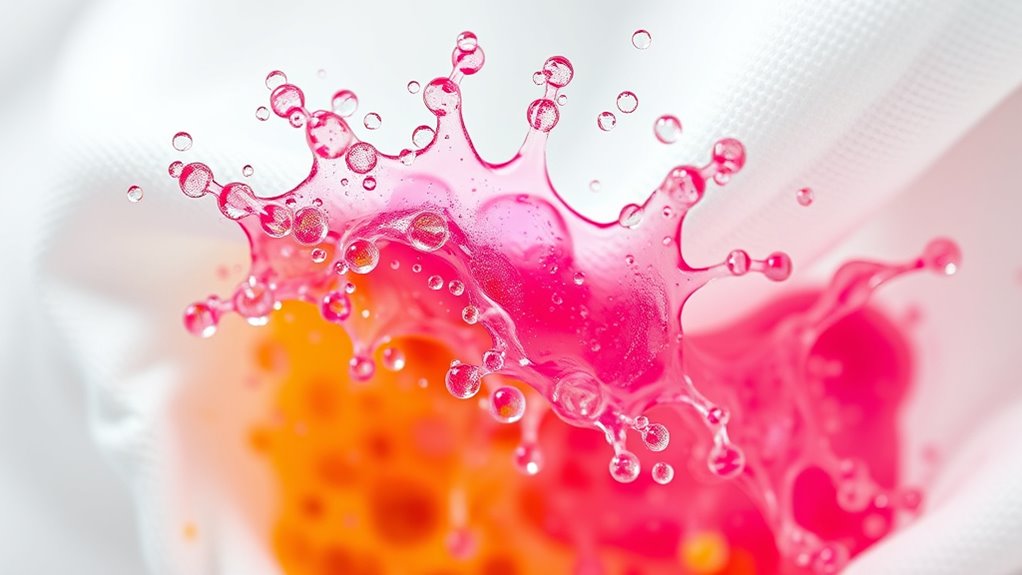
Understanding the role of enzymes in stain removal can greatly enhance your cleaning strategies. Enzymes, like proteases and lipases, are crucial components of effective stain removers. Proteases specifically target protein-based stains, such as blood and sweat, breaking them down into smaller fragments that are easier to wash away. On the other hand, lipases tackle greasy stains by breaking down fats and oils, allowing surfactants to encapsulate and remove them. Additionally, maintaining a high vibrational energy while cleaning can enhance your overall experience and effectiveness. For example, using enzymes in your cleaning routine can be as effective as using freshly squeezed juices for removing certain types of stains. Moreover, incorporating a supportive community can provide motivation and tips for tackling cleaning challenges.
If you’re dealing with starch-based stains, amylases convert starches into simpler sugars for easy rinsing. To maximize the effectiveness of these enzymes, use them at the correct temperatures, as certain enzymes perform best within specific ranges. This guarantees you get the most out of your stain removal efforts. Additionally, understanding the health and wellness benefits of maintaining a clean home can provide motivation to tackle stubborn stains effectively.
Oxidative Methods for Tackling Stains
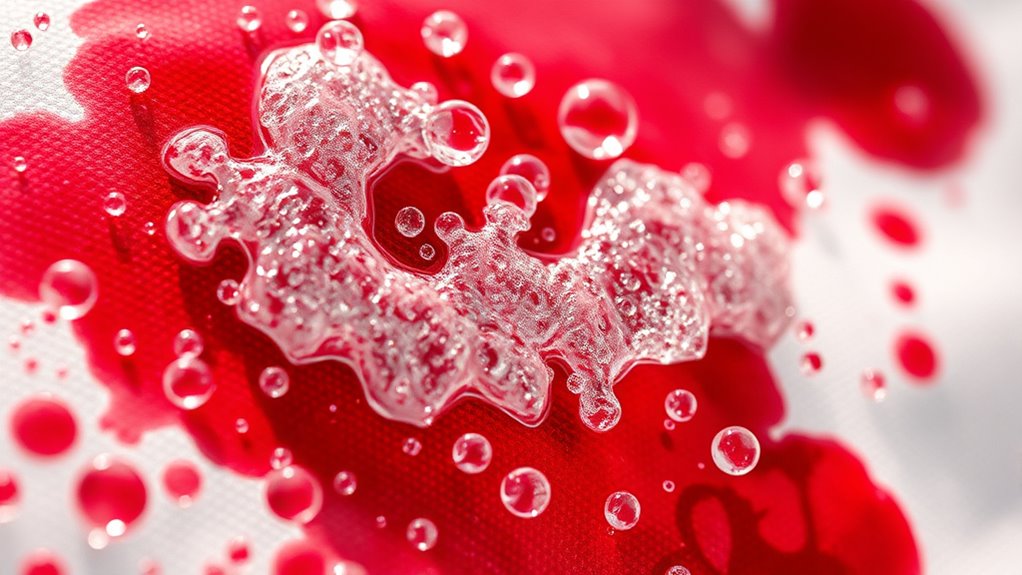
Oxidative methods can be a game changer for tackling tough stains. These techniques, including the use of hydrogen peroxide, break the chemical bonds of colored compounds, rendering them colorless and easier to wash away.
Oxidative methods, like hydrogen peroxide, effectively break down tough stains, making them easier to remove.
When you encounter difficult stains like tea, coffee, or wine, consider using sodium percarbonate, which releases hydrogen peroxide when mixed with water, enhancing your stain removal efforts. Regular maintenance of fabrics can further prevent the buildup of stubborn stains, ensuring they remain in good condition. Using effective cleaning tools can also simplify the process of stain removal. Additionally, employing an air purifier with HEPA filters in your cleaning space can help reduce allergens and improve air quality while you tackle stains.
Pairing hydrogen peroxide with TAED can boost its bleaching action at lower temperatures, making it suitable for various fabrics.
For particularly stubborn stains, peracetic acid acts as a powerful oxidizing agent, ensuring effective stain removal. Additionally, color accuracy plays a significant role in achieving the best results, as it ensures that the treated fabrics retain their original hues without unwanted discoloration.
Surfactants: The Key to Greasy Stain Removal

When you tackle greasy stains, surfactants play a vital role in your cleaning arsenal. These unique molecules form micelles that trap grease, allowing you to wash it away easily. Understanding the structure and types of surfactants can make all the difference in effectively removing those stubborn stains. Additionally, using surfactants derived from renewable energy sources can enhance environmental sustainability in cleaning products. For instance, many high-performance models of vacuum cleaners incorporate advanced cleaning technologies that utilize surfactants for improved stain removal. Furthermore, the effectiveness of these surfactants can be increased by choosing products that are energy-efficient stoves, which reduce overall environmental impact. Regular maintenance, such as filter replacement, can also enhance the performance of cleaning devices that rely on surfactants.
Surfactant Structure Explained
Surfactants play an essential role in tackling greasy stains, thanks to their unique structure. Each surfactant has a hydrophilic head that loves water and a hydrophobic tail that attracts oil.
When you add surfactants to a cleaning solution, they reduce the surface tension of water, allowing it to penetrate fabric fibers and lift tough stains more effectively. This interaction is vital for stain removal, as surfactants can encapsulate grease, making it easier to rinse away. Many smart home devices now incorporate advanced cleaning technologies that utilize surfactants for enhanced stain removal. Modern cleaning solutions are designed with energy-efficient systems that not only improve stain removal but also promote sustainable practices. Furthermore, understanding emergency preparedness essentials can help consumers choose the right cleaning products for various situations.
There are three types of surfactants—anionic, cationic, and nonionic—each designed for specific stain types. The concentration of surfactants also matters; higher concentrations typically lead to better cleaning efficiency, especially for stubborn greasy stains. Additionally, advancements in butter production have utilized similar principles of emulsification, showcasing the versatility of surfactants in various applications.
Micelles and Grease Removal
Understanding how surfactants work leads us to the concept of micelles, which are central to grease removal. Surfactants have a unique structure: a hydrophilic head that attracts water and a hydrophobic tail that grabs onto grease.
When you apply surfactants during cleaning, they form micelles that encapsulate grease molecules. This process makes greasy stain removal more efficient, allowing the grease to be washed away easily. Additionally, strong communication skills in the cleaning process can enhance teamwork and ensure that tasks are performed effectively. Incorporating chia seeds into your diet can also provide essential nutrients that support overall health, which can be beneficial during physically demanding cleaning tasks. Moreover, maintaining a clean environment with air purifiers can help reduce allergens that may complicate cleaning efforts.
Using warm water enhances the effectiveness of surfactants, as higher temperatures reduce grease viscosity, improving interaction. Additionally, surfactants lift and suspend grease in the wash water, preventing it from redepositing onto fabric surfaces. This guarantees a thorough cleaning, leaving your fabrics fresh and stain-free. Moreover, just as heat pumps improve air quality, the right surfactants can significantly enhance the cleaning process by effectively targeting and removing stubborn stains.
Types of Surfactants
While tackling greasy stains, knowing the different types of surfactants can make a big difference in your cleaning success.
Surfactants play a vital role in stain removal by breaking down grease and oil-based stains. The three main types of surfactants include:
- Anionic: Best for greasy stains; they bond with lipids and effectively lift them away.
- Cationic: Typically used for fabric softening and disinfecting rather than grease.
- Nonionic: Versatile and effective on various stains but less effective on greasy ones compared to anionic surfactants.
Using the right surfactant can enhance your cleaning efficiency, allowing you to use lower water temperatures and less agitation while still achieving great results against tough greasy stains. Additionally, choosing high-efficiency wood-burning stoves can also contribute to a cleaner environment by minimizing air pollutants associated with traditional heating methods. Regular maintenance of these stoves, including chimney cleaning, is also essential to prevent fire hazards and ensure optimal performance. For more effective cleaning, consider utilizing professional cleaning services that can provide specialized products and techniques tailored to your specific needs.
The Importance of Builders in Cleaning

When it comes to effective cleaning, builders are vital in enhancing the performance of laundry detergents. They work by softening water, which allows surfactants to break down stains more efficiently.
By removing calcium and magnesium ions, builders prevent these minerals from hindering the cleaning action. Common builders like sodium carbonate and polycarboxylates replace older options, ensuring both efficacy and environmental safety.
They also stop dirt and soil from redepositing onto fabrics during the wash, ensuring that stains are effectively lifted away. This is especially important for soil stains bound by calcium ions, as builders help detergents penetrate and clean efficiently.
In hard water areas, the presence of builders can greatly boost overall stain removal performance.
Special Considerations for Different Fabrics
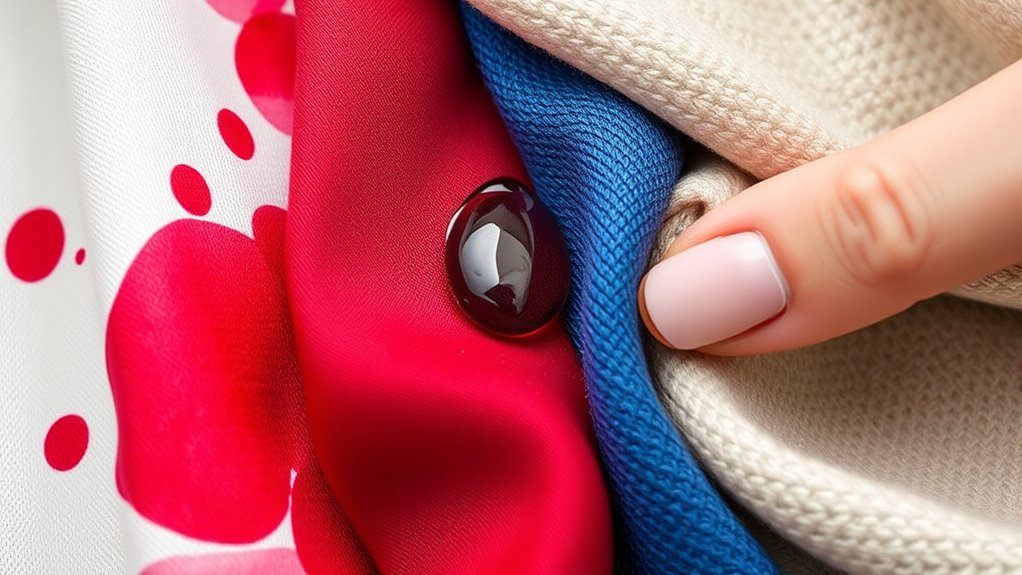
When it comes to stain removal, you need to take into account the type of fabric you’re dealing with.
Natural fibers soak up water-based stains easily, while synthetics handle oily substances better but can still be tricky.
Plus, always test cleaning solutions on older or delicate fabrics to avoid any unwanted damage.
Natural vs. Synthetic Fabrics
Understanding the differences between natural and synthetic fabrics is essential for effective stain removal, as each type presents unique challenges.
Natural fabrics like cotton and linen easily absorb water-based stains, while synthetic fabrics such as polyester repel water but can trap oily stains.
Here are some key considerations for stain removal:
- Natural fabrics require timely treatment, as their fibers hold onto stains tightly.
- Synthetic fabrics often need specific solvents for effective stain removal, as water can worsen oil-based stains.
- Always test stain removal agents on inconspicuous areas to avoid adverse reactions, like fading or weakening.
Age and Fabric Condition
As stains age, their removability diminishes, making it essential to act quickly on fresh spills. Older stains can become nearly permanent if not treated promptly.
The fabric condition also plays a significant role; natural fibers like cotton and wool absorb water-based stains more readily, complicating the removal process. Additionally, older fabrics may be more fragile, requiring gentler treatment to avoid tearing.
When dealing with delicate materials such as silk, you must be cautious, as certain solvents can cause irreversible damage or discoloration.
Testing Cleaning Solutions Safely
How can you guarantee that your cleaning solution won’t damage your fabric? Testing cleaning solutions safely is essential. Start with a patch test on a hidden area to check for discoloration or damage. This step is vital, especially for delicate fabrics.
Here are some tips to keep in mind:
- Use gentle methods like blotting with a cotton swab instead of rubbing, which can harm the fabric.
- Avoid alkaline or chlorine bleach on delicate fabrics like silk and wool, as they can weaken fibers.
- Consider the fabric’s age; older textiles may need milder solutions or professional cleaning.
Effective Techniques for Stain Treatment

Stain treatment can be surprisingly effective when you use the right techniques tailored to the specific type of stain.
For organic stains, consider enzymatic removers that break down proteins and fats. These products contain proteases, lipases, and amylases, enhancing stain removal efficiency.
If you’re dealing with oily stains, surfactants are key; they surround grease particles, allowing for easy rinsing during the wash.
For tannin stains from tea or coffee, oxidative treatments like hydrogen peroxide work wonders by breaking down color bonds.
Remember, always use cold water for protein-based stains to prevent them from setting into the fabric.
Choosing the right stain treatment not only protects your fabrics but also maximizes your chances of complete stain removal.
When to Seek Professional Help

When should you consider calling in the professionals for stain removal? If you’re dealing with stubborn stains or delicate fabrics, it’s time to seek help.
Professional dry cleaners use advanced techniques and specialized products that can save your garments.
Consider reaching out to a professional if:
- You’re working with delicate fabrics like silk or wool that require expert care.
- Stains persist despite multiple at-home treatments, risking permanent damage.
- You encounter complex stains, such as ink or multi-component stains like tomato sauce, that need specialized chemical solutions.
Frequently Asked Questions
What Is the Science Behind Stain Removal?
When tackling stains, it’s all about understanding the types involved. You’ve got protein, oil, tannin, and dye stains, each needing a specific treatment.
Enzymatic removers break down organic materials, while oxidative agents like bleach tackle tannin stains. Surfactants lift dirt and grease, making cleanup easier.
The key is to act fast; fresh stains are simpler to remove since they haven’t yet set into the fabric. So, get to it right away!
What Is the Number One Rule of Stain Removal?
The number one rule of stain removal is to act quickly.
You’ll find that fresh stains are much easier to tackle than set-in ones. If you wait too long, those stains can become permanent residents on your fabric.
Always remember to blot gently with a clean cloth instead of rubbing, which can spread the stain.
Is There a Stain Remover That Actually Works?
Yes, there are stain removers that really work!
When you’re dealing with tough stains, look for products with enzymes, surfactants, or oxidative agents, as they target specific stain components effectively.
For example, enzymatic removers tackle organic stains like blood or grease, while oxidative ones handle tannin-based stains from coffee or wine.
Just remember to choose the right type based on the stain you’re facing, and you’ll boost your chances of success considerably!
What Is the Principles of Stain Removal?
The principles of stain removal focus on identifying the type of stain and using the right cleaning agents.
You need to match water-based stains with appropriate solutions, while oil-based stains require different treatments.
Enzymatic cleaners break down proteins and fats, making stains easier to wash away.
Surfactants help lift stains off fabrics, and applying treatments quickly can greatly improve your chances of removing fresh stains before they set into the fabric.
Conclusion
In the battle against stains, you’ve got the tools and knowledge to emerge victorious. Picture yourself as a stain-fighting superhero, armed with enzymes and surfactants, swooping in to save your favorite fabrics. With each treatment, you’re not just lifting stains; you’re restoring beauty and confidence. Whether tackling a stubborn red wine spill or a greasy mark, remember: every stain tells a story, but with your newfound skills, you can turn the page to a fresh, clean chapter.

